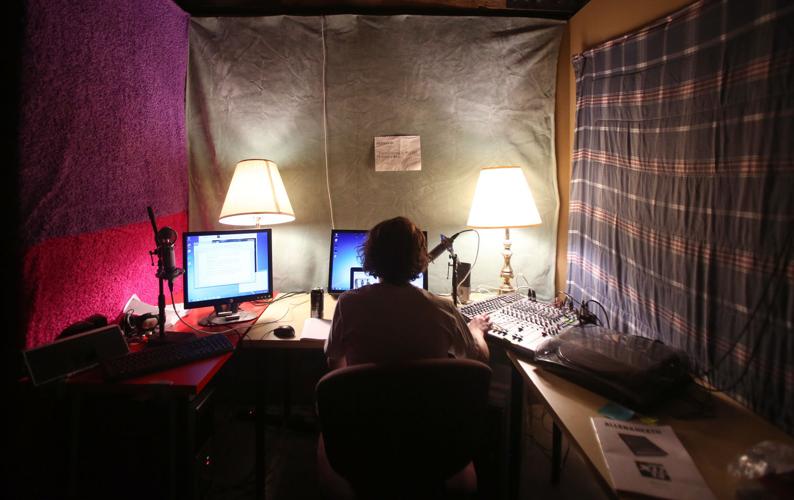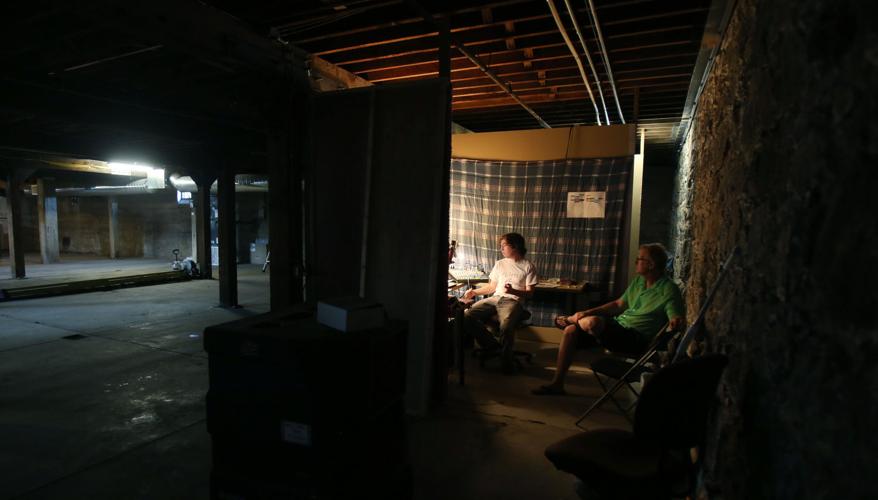Tucked away inside a basement in the warehouse arts district, Nick Cashman carefully selected the playlist for his show on Tucson’s newest radio station, KTDT Downtown Radio 99.1 FM.
“I’m a big music nerd,” Cashman, 23, said as he lined up songs from “bands I like that aren’t getting airplay anywhere else.” All the while, he wrote the song names in a spiral notebook to make sure he doesn’t repeat them on future shows.
Downtown Radio’s first broadcast Sept. 13 marked the arrival of the second wave of low-power FM stations in Tucson. A handful of the stations, which are nonprofit, educational and broadcast at 100 watts or less, are set to hit local airwaves in the coming months.
“The station is about exposing people to great local artists they may not have heard before and certain artists that aren’t being played on commercial radio,” said program director Jason LeValley.
Tucson artists, such as Louise Le Hir, Sugar Stains, and Trans Van Santos, will be broadcast from the antenna atop the Sinfonia Healthcare building at 1 East Toole where the station is housed, along with non-Tucson musical acts like Of Montreal, Elliot Smith and the Black Angels.
While music makes up most of the station’s programming, the station also will broadcast a spiritual show, a comedy show, and a show about dealing with depression that will be “funny, informative, and engaging,” said LeValley, 50.
“One of our goals at the station is to reduce the stigma that’s associated with seeking help for mental health issues,” LeValley said, adding other local organizations that are not associated with mental health care, such as Youth on Their Own, also will appear on the station.
The first low-power FM stations popped up in Tucson a decade ago when Pueblo Magnet High School and the Pascua Yaqui Tribe were granted licenses following the first-ever application window in 2001.
The Federal Communications Commission received 3,250 applications nationwide during that window and granted 1,325 licenses. The window closed until a two-month period in late 2013, when about 2,800 applications resulted in more than 1,900 licenses.
The FCC issued construction permits, which give the green light to build the radio station but not to start broadcasting, to Xerocraft, Global Change Multi-Media, StopAbortion.org, Message Radio of Tucson, and Iglesia Centro de Sanidad.
The Pascua Yaqui Tribe also was granted a construction permit to start another station for the Old Pascua community near West Grant and North Oracle roads.
Statewide, 20 low-power FM stations are on the air and another 31 were issued construction permits.
The do-it-yourself workshop Xerocraft spent the summer raising money for KMKR “Maker” 100.1 FM. With a little more fundraising, organizers expect to be on the air in a few months, said board member Terry Nordbrock.
The Pascua Yaqui Tribe’s KPYT, which has operated since 2005, broadcasts a wide array of music, as well as public service programs dealing with diabetes prevention, parenting and other topics, said station manager Hector Youtsey.
With the new station near Oracle and Grant, Youtsey expects the tribe’s radio audience to more than double to 10,000 listeners.
For the time being, Downtown Radio is broadcasting at 50 watts, which reaches about 250,000 people in downtown, southern Tucson, the University of Arizona campus, and as far north as the Foothills, LeValley said.
Most low-power stations broadcast at 100 watts, but due to international treaty obligations, stations near the U.S.-Mexico border must wait several months to make sure the Mexican government does not object before increasing their wattage.
For Cashman, low-power radio is a way to inject local, diverse music into a radio dial dominated by large corporations.
“Clear Channel has a monopoly on a medium, which I think is wrong,” Cashman said. “We’re the alternative to that.”
Industry giants Cumulus Media, Lotus Communications Corp, Journal Broadcasting Group, and iHeartRadio, formerly known as Clear Channel Communications, own a total of 15 FM stations in Tucson.
The National Association of Broadcasters, an industry group for commercial, full-power stations, was a longtime opponent of low-power FM licenses.
The full-power stations worried the low-power stations would interfere with their signals, particularly with listeners who live near or drive by low-power stations, said Dennis Wharton, a spokesman for the association.
But the two sides reached an accommodation a few years ago on technical rules to minimize interference, he said. And because low-power stations do not sell advertising, “we don’t view them as a competitive threat.”
“We’re OK with the LPFMs and hopefully, I think we can live in harmony,” Wharton said.
Back in the Downtown Radio studio, which Sinfonia CEO Fletcher McCusker provides free of charge, plans are in motion to double the studio space, add a bathroom and create a venue for live music.
The station already has DJs, but volunteers are needed, LeValley said. He asked anyone interested in volunteering at Downtown Radio to contact him at admin@downtownradio.org
Like most low-power stations, Downtown Radio relies on community support such as pledge drives, grants, and underwriting, LeValley said. So far, he has verbal commitments from several business owners to underwrite the station.
“We’re where we want to be. The station is up and running and I’ve already planted the seeds for underwriting,” he said. “I think Downtown Radio is here to stay.”







